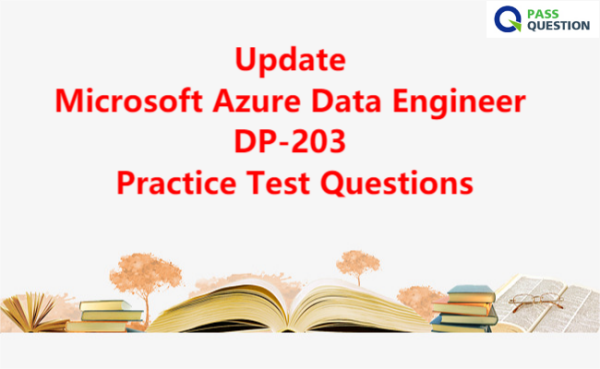Update Microsoft Azure Data Engineer DP-203 Practice Test Questions
Candidates who pass the DP-203 Data Engineering on Microsoft Azure exam will earn the Microsoft Certified: Azure Data Engineer Associate certification. PassQuestion provides the high quality Microsoft Azure Data Engineer DP-203 Practice Test Questions to help you best prepare for your Microsoft DP-203 exam. With the help of our Microsoft Azure Data Engineer DP-203 Practice Test Questions, you will be able to practice as much as you want before taking the real exam. It will give you a clear idea to understand the real exam scenario and you will be able to improve your preparation. You just have to prepare the provided DP-203 Practice Test Questions once and you will be able to clear the exam in a single attempt.

Data Engineering on Microsoft Azure (DP-203)
The Microsoft Azure Data Engineer (DP-203) is an advanced-level certification exam from Microsoft Azure. By enrolling for this certification you get the credibility and can validate your Azure Data Engineer skills such as designing and implementing data storage and data security, Designing and Developing data processing, and Monitoring and optimizing data storage and data processing.
Being an Azure Data Engineer, you can ensure that data pipelines and data stores are high-performing, efficient, organized, and reliable, based on business requirements and constraints. You will also be able to design, implement, monitor, and optimize data platforms to meet the needs of data pipelines. Therefore, once you understand and master these concepts you can easily become a successful Azure Data Engineer.
Exam Information
Exam Code: DP-203
Number of Questions: 40-60 questions
Duaration: 130 Minutes
Cost: $165 USD
Passing Score: 700
Language: English
Learning Objectives
Design and implement data storage on Azure
Design and develop data processing on Azure
Design and implement data security on Azure
Monitor and optimize data storage and data processing on Azure
View Online Microsoft Certified: Azure Data Engineer Associate DP-203 Free Questions
You need to integrate the on-premises data sources and Azure Synapse Analytics. The solution must meet the data integration requirements.
Which type of integration runtime should you use?
A. Azure-SSIS integration runtime
B. self-hosted integration runtime
C. Azure integration runtime
Answer: C
You need to design a data retention solution for the Twitter teed data records. The solution must meet the customer sentiment analytics requirements.
Which Azure Storage functionality should you include in the solution?
A. time-based retention
B. change feed
C. soft delete
D. Iifecycle management
Answer: D
You need to design a data retention solution for the Twitter feed data records. The solution must meet the customer sentiment analytics requirements.
Which Azure Storage functionality should you include in the solution?
A. change feed
B. soft delete
C. time-based retention
D. lifecycle management
Answer: D
What should you do to improve high availability of the real-time data processing solution?
A. Deploy identical Azure Stream Analytics jobs to paired regions in Azure.
B. Deploy a High Concurrency Databricks cluster.
C. Deploy an Azure Stream Analytics job and use an Azure Automation runbook to check the status of the job and to start the job if it stops.
D. Set Data Lake Storage to use geo-redundant storage (GRS).
Answer: A
You have two Azure Data Factory instances named ADFdev and ADFprod. ADFdev connects to an Azure DevOps Git repository.
You publish changes from the main branch of the Git repository to ADFdev.
You need to deploy the artifacts from ADFdev to ADFprod.
What should you do first?
A. From ADFdev, modify the Git configuration.
B. From ADFdev, create a linked service.
C. From Azure DevOps, create a release pipeline.
D. From Azure DevOps, update the main branch.
Answer: C
You need to trigger an Azure Data Factory pipeline when a file arrives in an Azure Data Lake Storage Gen2 container.
Which resource provider should you enable?
A. Microsoft.Sql
B. Microsoft-Automation
C. Microsoft.EventGrid
D. Microsoft.EventHub
Answer: C
You are designing an Azure Databricks interactive cluster. The cluster will be used infrequently and will be configured for auto-termination.
You need to ensure that the cluster configuration is retained indefinitely after the cluster is terminated. The solution must minimize costs.
What should you do?
A. Clone the cluster after it is terminated.
B. Terminate the cluster manually when processing completes.
C. Create an Azure runbook that starts the cluster every 90 days.
D. Pin the cluster.
Answer: D
You have an Azure Synapse Analytics dedicated SQL pool named Pool1 and a database named DB1. DB1 contains a fact table named Table1.
You need to identify the extent of the data skew in Table1.
What should you do in Synapse Studio?
A. Connect to the built-in pool and run dbcc pdw_showspaceused.
B. Connect to the built-in pool and run dbcc checkalloc.
C. Connect to Pool1 and query sys.dm_pdw_node_scacus.
D. Connect to Pool1 and query sys.dm_pdw_nodes_db_partition_scacs.
Answer: D
- TOP 50 Exam Questions
-
Exam
All copyrights reserved 2025 PassQuestion NETWORK CO.,LIMITED. All Rights Reserved.

